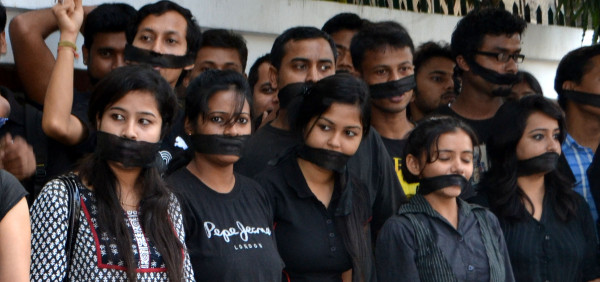Depending fully on advertisement revenues, as the monetary contributions from millions of viewers never go to the ‘free to air’ news channels, one always ponder on how these media outlets can pursue ethical and impartial journalism. In this regard the closure of a Guwahati based satellite news channel last year unearthed many odd facets of the distribution process of television channels across India.
By Nava J. Thakuria
When the news came on October 1, 2013 regarding the decision of the management of Prime News, a 24×7 private news channel, was to suspend its telecast immediately, an quite astounding issue relating to the ambiguity of news channels’ distribution process also surfaced. It revealed that the owner of a news channel registered as free to air with the Indian information and broadcasting ministry has to spend for everything including the production and also distribution of its news and other programmes to its viewers, and amazingly the whole of the expenditures have to be compensated from the advertisements.
The channel owner does not get any amount of money from its subscribers, maybe counted in the millions. Indirectly it means that the advertisers, not the viewers always enjoy a major say in the content of the free to air news channels irrespective of merit and authenticity.
Just before closing down the news channel, the management of Prime News appraised its employees of the fact that was it asked to pay nearly Indian rupees two crore by the cable network of Assam as a distribution or carriage fees, but the management could not manage it.
In its response, the cable operators blacked-out Prime News for nearly three weeks in September 2013. Moreover, the Prime News had no slot in any of private direct-to-home (DTH) services of India and hence the viewers were not able to enjoy any news or other programmes of the channel for all those days, resulting in a very poor television rating.
Taking advantages of the situation, the proprietor suddenly decided to close down the channel, so argued the employees of Prime News. The owners of Guwahati based private news channels, all are registered as free to air, reveal that they have to pay over rupees two crore (20 million), which is one sixth of their annual expenditure, to the cable network operators across Assam every year for facilitating the distribution of their programmes to the subscribers (or viewers).
The cable television operators’ association in Guwahati meanwhile argues that they have the lawful right to receive money from the channel owners as the ‘carriage fee’. They also claimed that the carriage fee is legitimate for free to air channels (yet not in case of paid news channels) under the legal procedures of the Union Information & Broadcasting Ministry and Telecom Regulatory Authority of India (TRAI). The TRAI, not only the local cable network, demanded money to the tune of crores and that was also put forward by the private DTH service providers.
The news channel owners in Guwahati claim that they have to pay over rupees 2.5 crore for the entry into the DTH space. Moreover, the DTH operators in India namely, Dish TV, Tata Sky, Sun Direct, Airtel Digital TV, Reliance Digital TV, Videocon D2H, BIG TV etc always select a bunch of channels with the motive of profit only, irrespective of the commitment of the concerned channels to the country and the nation.
Worth mentioning here also is that the DTH services have completed 10 years in India, as New Delhi issued the license to Dish TV to operate in the country since October 2003. Initially concentrated on the rural market of India, where the cable operators are not visible even today, the DTH operator slowly encroached into the city and metros.
By 2006, Tata Sky had joined in the competition with high quality signal and a kind of choice for the subscribers to select their package of channels. The rest of the DTH operators had stepped into the business in and, after 2008, gave a huge boost to the Indian television distribution market. Today, the DTH operators tap over 40 million active subscribers in India and the number is increasing every month.
With quality transmission, the DTH operators have empowered the subscribers to select their packages (unlike depending on the mercy of cable operators in case of cable connection) and also the broadcasters to know the exact number of subscribers across the country, whereas the cable operators show lower number of subscribers they always siphon off a huge amount of the subscription moneis.
Both the offices of Union Information & Broadcasting Ministry and the TRAI were contacted for their points of view in this respect, but no communiqué as response was received. India, with a population of over one billion today, supports more than 800 local satellite television channels, more than half of those are news channels airing programmes in different languages.
Union Ministry sources reveal that there are over 410 privately owned news and current affairs channels up till March 2013 in India mounting the news broadcasting industry up to 20 billion rupees worth business.
Subhash Chandra, chairperson of Zee Entertainment Enterprises, recently claimed that the Indian news channels were making losses and there was no room for so many news channels in the country. Speaking to journalists in Mumbai, the Zee television chief however admitted that the media isn’t free of corruption and it is a cause for concern. Mr Chandra also predicted that the corruption in the media would rise further but that there would be correction.
Journalists’ Forum Assam (JFA), an active media person’s organization, has raised voices for reforming the distribution system of local news channels. The JFA, in a recent letter to Manish Tiwari, Union Information & Broadcasting minister, argued that the transactions between the channel owner and the cable network operators as well as the DTH authority should be made accountable under the income tax department of the country.










